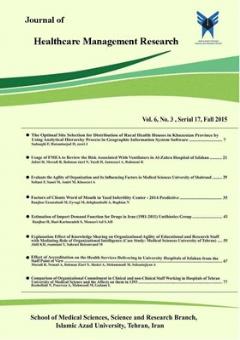تحلیل علت ها و پیامدهای فرسودگی شغلی پرستاران بر اساس پژوهش زمینه ای
الموضوعات :
1 - گروه روانشناسی بالینی،واحد علوم و تحقیقات، دانشگاه آزاد اسلامی، تهران، ایران
الکلمات المفتاحية: فرسودگی شغلی, پرستار, بیمارستان, مراکز درمانی, راهبردهای درمانی, پژوهش زمینهای مقدمه,
ملخص المقالة :
مقدمه: یکی از مشاغل مهم درمانی و بهداشتی مهم درگیر پدیده فرسودگی شغلی، پرستاری است. رصد تحولات، نگرشها، علتها، بسترها، مداخلات و پیامدهای این پدیده در این میان پرستاران میتواند زمینهساز سیاستگذاریهای نیروی انسانی مراکز بهداشتی و درمانی برای کنترل آسیبهای آن باشد.
روش پژوهش : این پژوهش علتها و پیامدهای فرسودگی شغلی و راهبردهای کنترل آن را به شیوه پژوهش زمینهای از منظر پرستاران شاغل شهر تهران بررسی نموده است. نمونه گیری با شیوه نظری، و تعداد افراد مورد مصاحبه(حجم نمونه) بر اساس اشباع نظری، 45 پرستار از کادر درمانی شهر تهران می باشد. پس از انجام مصاحبه نیمه ساختار یافته، دادهها به شيوه نظاممند استراوس و کوربين تجزیه و تحلیل شدند.
یافته ها : 144 کد اوليه، 34 مقوله فرعي، 13 مقولة اصلي و يك مقولة هستهای از کدگذاری دادهها استخراج و مدل پارادايمي در قالب شرايط علي، مداخله گر، زمينه اي، راهبردها و پيامدها شکل گرفت. یافتههای پژوهش بر اساس این مدل حاکی است پدیده فرسودگی شغلی پرستاران که از علتهای تعارض شغلی و علتهای شغلی و سازمانی منشاء میگیرد در بستر تعاملی و اجتماعی و مداخله فشار نیروی انسانی و فشار اجتماعی به پیامدهای منفی فردی، خانوادگی، اجتماعی و شغلی منتهی میشود و کیفیت زندگی شغلی، فردی و خانوادگی آنها را تنزل میدهد.
نتیجهگیری : در راستای کاهش فرسودگی شغلی پرستاران، بهره گیری از راهبردهای فردی(سازگاری فردی، مشاوره و روانکاوی)، راهبردهای خانوادگی(حمایت خانوادگی) و راهبردهای سازمانی(کاهش تعارض شغلی-خانوادگی، اصلاح ساختار سازمانی، مشارکت پرستاران در سیاستگذاری ها و تکریم و تشویق آنها، اصلاح تعاملات سازمانی، تقویت نیروی انسانی، اصلاح تعاملات اجتماعی بین پرستاران با جامعه) ضرورت دارد.
[1] Rouzban, R.; & Saki, R. 2012. Investigating the Relationship between Teachers’ Occupational Burnout, Organizational Commitment and Job Motivation among Elementary School Teachers in the Public Schools in Nazar Abad city, Iran, in the academic year 2011-2012. Master's thesis, Faculty of Humanities and Physical Education, Shahid Rajaei Teacher Training University.
[2] Heydari, A.; & Rastgoo, F. 2024. Reasons for Nurses' Migration: A Narrative Review of Health Research and Development, 2 (3): 13-23.
[3] Freudenberger, H. J. 1975. The Staffʼs Occupational Burnout Syndrome in Alternative Institutions. Psychotherapy: Theory, Research & Practice, 12(1), 73.
[4] Bordbarian, F.; Mahzabi, M.; & Jafari, S. M. B. 2015. Assessment of Occupational Burnout and Identifying Its Factors in Shiraz Regional Electricity Company. Fourth National Conference and Second International Conference on Accounting and Management.
[5] Guo, J., Chen, J., Fu, J., Ge, X., Chen, M., & Liu, Y. 2016. Structural Empowerment, Job Stress and Occupational Burnout among Nurses in China. Applied Nursing Research, 31, 41-45.
[6] Samadi-Miarkalaei, H.; Hosseini, S. Z.; & Samadi-Miarkalai, H. 2017. Analyzing the Effects of Job Security on Nurses' Occupational Burnout Syndrome. Quarterly Journal of Nursing Management, 5(3): 71-79.
[7] Janeway, D. (2020). The role of psychiatry in treating burnout among nurses during the Covid-19 pandemic. Journal of radiology nursing, 39(3), 176-178.
[8] Shams, H.; & Mousavi, S. A. 2012. Investigating a Role’s stressful Factors, Occupational Burnout, and Job Enrichment on Improving Employeesʼ Performances (A Case study: Saderat Bank Branches in Shiraz, Iran) Master's thesis, Faculty of Humanities, Payam Noor University, Fars Province, Iran.
[9] Ross, J. 2020. The Exacerbation of Occupational Burnout during COVID-19: A Major Concern for Nurses Safety. Journal of Perianesthesia Nursing, 35(4), 439-440.
[10] Habibi, E.; Dadkhah Tehrani, S.; Gharebaei, S.; & Mahaki, B. 2015. Investigating the Relationship between Shift Work and Occupational Burnout among Nurses at Al-Zahra Hospital Using Maslach Burnout Questionnaire. Health System Research, 11(1), 641-650.
[11] Farsi, Z.; Rajaee, N.; & Habibi, H. 2014. Investigating the relationship between Occupational Burnout and the Quality of Work Life among Nurses Working in IRI Army’s Affiliated Hospitals in Tehran. Military Caring Sciences, 1(2 (Issue 2), 63-72.
[12] Rangriz, H.; Mousavi, S. Z. 2014. The Effects of Occupational Burnout due to Workload and Shortage of Nurses in Iranian hospitals Considering the General Health Policies. Strategic and Macro Policies, 2(7), 43-64.
[13] Abdi Masooleh, F.; Kaviani, H.; Khaghanizadeh, M.; & Momeni Eraghi, A. 2007. Investigating the Relationship between Occupational Burnout and Mental Health: A Study among 200 Nurses. Journal of the Faculty of Medicine, 65(6), 65-75.
[14] Hakim Shushtari, M.; Khajeh al-Din, N.; Arabgol, F.; & Elahi, F. 2004. The Relationship between Occupational Burnout Syndrome among Nursing Mothers and Behavioral Problems among Their Children. Cognitive Science Updates, 6 (1-2 (Issue 22)), 67-72.
[15] Strauss, A.; & Corbin, J. 2016. Fundamentals of Qualitative Research: Techniques and Steps for Generating Grounded Theory. Persian Translation by Ebrahim Afshar, Ney Pub., Tehran.
[16] Strauss, A., & Corbin, J.1994. Grounded Theory Methodology: An Overview. In N. Denzinin, & Y. Lincoln (Eds), Handbook of Qualitative Research. Thousand oaks, CA: Sage.
[17] Goulding, C. 2002. Grounded Theory: A Practical Guide for Management, Business& Market Researchers, London: Sage Publications.
[18] 18. Maslach C, Jackson SE. 2001. The Measurement of Experienced Burnout. Journal of occupational behavior. 2(2):99-113.
[19] 19. Hultman, C. S., & Neumeister, M. W. 2017. Wellness and Burnout in Burn Care Providers: Professionalism, the Social Covenant, and the 7 Habits of Highly Effective Teams. Clinics in Plastic Surgery, 44(4), 943-948.
[20] 20. Schwarzkopf, K., Straus, D., Porschke, H., Znoj, H., Conrad, N., Schmidt-Trucksäss, A., & von Känel, R. 2016. Empirical Evidence for a Relationship between Narcissistic Personality Traits and Occupational Burnout. Burnout Research, 3(2), 25-33.
[21] 21. Liu, J., Wang, W., Hu, Q., Wang, P., Lei, L., & Jiang, S. 2021. The Relationship between Phubbing and the Depression in Primary and Secondary School Teachers: A Moderated Mediation Model of Rumination and Occupational Burnout. Journal of Affective Disorders, 295, 498-504.


